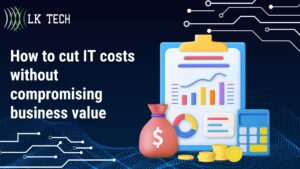How to strategically cut IT costs without compromising business value
The economic landscape is uncertain. Competition is fierce. Shareholders have high expectations. Regulatory requirements continue to evolve. For today's CIOs, the pressure is on to optimize IT budgets and direct more spending toward future growth opportunities. Simply put, no enterprise can afford unnecessary IT costs that fail to deliver real business impact.
At the same time, digital transformation remains a top priority. CEOs want CIOs to drive innovation and business improvements through technology, even as budgets stay flat. The key is striking the right balance between fiscal prudence and enabling technology-fueled progress.

- How to cut IT costs without compromising business value
Take a holistic approach to the IT portfolio
A comprehensive examination of the existing IT portfolio is the first step. As LK Technologies, a leading IT services company serving Cincinnati, notes on its website, CIOs must take "a long, hard look at IT costs" to align technology investments with corporate strategy.
Areas ripe for evaluation include:
- Cloud costs: Cloud consumption, pricing models, and utilization rates all warrant scrutiny, as expenses can quickly spiral out of control. FinOps practices such as tagging, monitoring, and right-sizing resources can help rein in waste and ensure cloud spending aligns with business needs.
- Project portfolio: Reprioritizing or pausing projects based on anticipated ROI, feasibility, and current business priorities clears away activities that no longer make strategic sense. Ranking projects by value and adjusting timelines helps focus on high-impact initiatives.
- Support levels: Right-size support plans to actual business requirements rather than defaulting to the highest service tier. Analyze past incident response times and end-user feedback to determine optimal support levels.
- Vendor contracts: Renegotiate agreements to capture savings and reduce services that no longer deliver value. Consolidate contracts when possible and leverage SaaS-based pricing models for greater flexibility.
- Applications portfolio: Eliminate redundant, outdated, or underutilized applications to streamline operations. Sunset legacy systems where possible to reduce maintenance IT costs. Adopt SaaS alternatives to minimize overhead.
- Sourcing models: Consider insourcing, contingent labor, and agile arrangements to improve flexibility and cost efficiency. Leverage managed services providers (MSPs) strategically for niche expertise without inflating headcount.
- Hardware refresh cycles: Extend refresh cycles where feasible and transition to cloud infrastructure to reduce capital outlays. Virtualization and containerization can also optimize hardware usage.
- BYOD policies: Implement bring-your-own-device (BYOD) programs with appropriate security controls to shift end-user hardware costs.

- IT Cost Reduction Strategies
Double down on technology debt reduction
Technical debt - the IT cost of maintaining outdated legacy systems - is a common budget sinkhole. As Gartner suggests, CIOs must "take out the tech trash" by sunsetting solutions past their prime and modernizing core platforms.
While ditching longstanding systems may seem daunting, the risks and expenses only compound over time. Continued maintenance, integration challenges, and lack of agility all add up. Allocating savings captured from the IT portfolio review to pay down debt can free up significant funding down the road.
Some best practices for tackling technology debt include:
- Prioritize modernization efforts based on potential value and current pain points
- Take an incremental, modular approach to minimize disruption
- Involve business stakeholders to validate priorities and needs
- Sunset legacy systems in phases while ramping up new solutions
- Provide ample training and communication around changes
- Start small with pilot projects to test modernization approaches
With a strategic roadmap and phased rollout, CIOs can gradually transform legacy systems into agile, scalable platforms that provide a foundation for innovation.
Invest in automation
Process automation presents a massive opportunity to curtail IT costs and boost productivity. Monitoring, backups, provisioning, and other routine IT tasks are prime automation targets. The more that can be handled without human intervention, the greater the efficiency gains.
Intelligent automation technologies like robotic process automation (RPA), AI, and machine learning can amplify the benefits even further. By mimicking human actions and decision-making, these tools can automate more complex workflows.
| Type of Automation | Potential Benefits |
| IT process automation | Improved efficiency, reduced IT costs |
| Infrastructure automation | Faster provisioning, reduced errors |
| Security automation | Rapid threat response, proactive protection |
| Intelligent automation | Handle complex processes and decisions |
| Automation + AI | Continuous process optimization |
To maximize returns on automation investments:
- Identify processes involving repetitive, rules-based tasks
- Start with a small pilot project to demonstrate the value
- Choose tools that integrate with existing systems and workflows
- Phase in automation incrementally across the organization
- Continuously monitor and refine automated processes
- Retrain staff to handle higher-value responsibilities
Keep the business vision in focus
Not all cost-cutting is created equal. Indiscriminate budget slashing can severely hamper an organization's competitiveness and growth potential. As LK Technologies emphasizes, CIOs must find the "balance between being conservative and positioning the IT organization to grow."
The goal should be maximizing business value, not minimizing IT expense for its own sake. With a strategic approach, CIOs can optimize budgets in a way that advances corporate objectives and sets the stage for innovation.
Some guiding principles include:
- Align with business goals - Ensure IT cost optimization maps to strategic priorities and desired outcomes.
- Involve stakeholders - Partner with business leaders to identify high-impact investment areas.
- Support growth - Double down on technologies that create competitive advantage and enable new opportunities.
- Manage risk - Weigh cost reductions against potential vulnerabilities and loss of agility.
- Take the long view - Look beyond immediate savings to consider downstream impacts and benefits over time.
- Communicate changes - Provide transparency around IT changes and how they support the business.
With CIOs serving as strategic advisors, IT can transform from a cost center to a value center that drives innovation, productivity, and revenue growth. A thoughtful, business-aligned approach to cost optimization creates budget headroom to fund forward-looking initiatives and next-generation capabilities.
Rather than across-the-board cuts, CIOs must make judicious trade-offs based on business priorities, risks, and future needs. This requires an intimate understanding of corporate objectives along with an IT operating model that balances fiscal prudence with strategic investment. Done right, IT cost optimization becomes a vital enabler of the digital transformation agenda.
At LK Tech IT company in Cincinnati, we provide top-notch support tailored to your specific needs, ensuring your systems are secure and running smoothly. Contact us today to discover how partnering with an experienced IT company can help your business!


